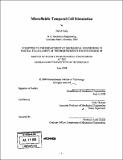Microfluidic temporal cell stimulation
Author(s)
Craig, David, S.M. Massachusetts Institute of Technology
DownloadFull printable version (9.665Mb)
Other Contributors
Massachusetts Institute of Technology. Dept. of Mechanical Engineering.
Advisor
Todd Thorsen.
Terms of use
Metadata
Show full item recordAbstract
This thesis presents a novel microfluidic platform for investigating cellular signaling networks, combining a programmable system for generating arbitrarily complex temporal input stimulant concentration profiles with real-time fluorogenic monitoring of cell physiological response. While cellular assay automation has been demonstrated in microfluidic devices, applying microfluidics to more difficult, multi-parametric systems biology problems, like the analysis of signal transduction pathways, requires a higher level of automation to rigorously control environmental parameters and detect output signals. Addressing this challenge, I developed a JAVA-based programmable microvalve system for automated control of reagent delivery enabling the end user to generate complex chemical waveforms and perform multiple assays on individually addressable cell chambers on chip. Typically, signaling behavior has been inferred from cellular responses to step inputs or slow square waves [1-3]. Generation of arbitrary waveforms in these experiments involved either complex programmable syringe pump systems or physically moving a sample through a spatial gradient to create temporal changes [4, 5]. My device used computer-controlled elastomer valves to dynamically generate arbitrary concentration profiles with waveform periodicities as short as 10 seconds. This kind of complex signal input to cellular networks has not previously been reported. To demonstrate this platform, experiments were performed monitoring the change of intracellular free calcium in response to the application of histamine. Cells were treated with a dye that fluoresces only when bound to calcium within the cytosolic compartment. (cont.) Live cell imaging was used to observe both spontaneous oscillations in response to constant stimulant concentrations as well as response peaks driven by applied waveforms generated on-chip. This system allowed the following of the response of individual cells to changes in applied stimulant. Using this platform, scientists can create new, complex input signals and observe output responses, opening new avenues of experimentation in systems biology.
Description
Thesis (S.M.)--Massachusetts Institute of Technology, Dept. of Mechanical Engineering, 2008. Includes bibliographical references (p. 39-40).
Date issued
2008Department
Massachusetts Institute of Technology. Department of Mechanical EngineeringPublisher
Massachusetts Institute of Technology
Keywords
Mechanical Engineering.